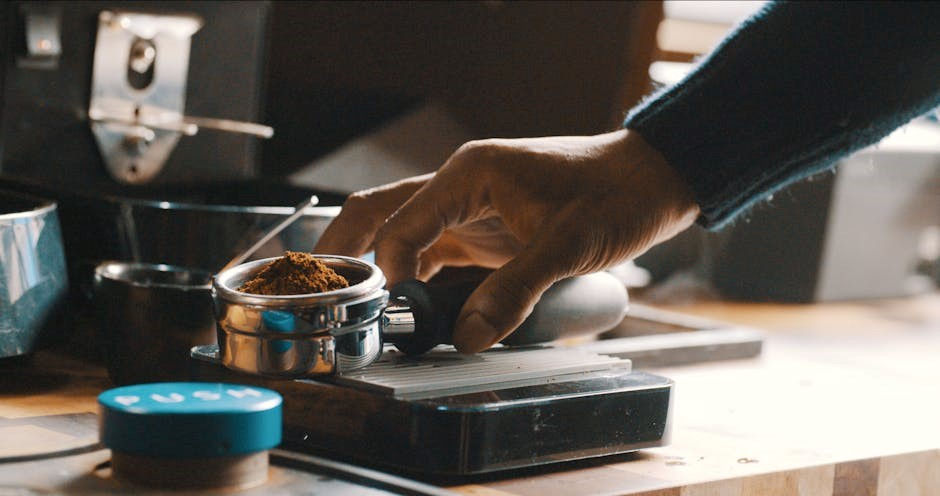
spice grinder manual
A manual spice grinder offers a simple, cost-effective way to grind spices, providing control over texture and freshness․ Ideal for small quantities, it enhances flavor in cooking․
By turning a handle or crank, users can effortlessly grind spices to desired consistency, ensuring maximum aroma and taste without electricity․ Perfect for home cooks and enthusiasts․
What is a Spice Grinder?
A spice grinder is a kitchen tool designed to grind whole spices, herbs, and other ingredients into a fine or coarse powder․ Manual spice grinders, in particular, operate without electricity, relying on a handle or crank for operation․ These devices typically consist of a chamber for holding the spices and a grinding mechanism, such as blades or burrs, that crush the spices as you turn the handle․ They are ideal for small quantities and offer precise control over the grind size, ensuring fresh and flavorful results․ Unlike electric grinders, manual models are quieter, more portable, and often more affordable․ They are a versatile addition to any kitchen, perfect for enhancing the aroma and taste of dishes by grinding spices just before use․
Why Use a Spice Grinder?
Using a spice grinder, especially a manual one, enhances the flavor and aroma of your dishes by allowing you to grind spices fresh just before use․ This ensures optimal potency and fragrance, as pre-ground spices can lose their vibrancy over time․ Manual grinders are cost-effective, portable, and require no electricity, making them ideal for home cooks and enthusiasts․ They also provide control over grind size, letting you achieve the perfect texture for your recipes․ Additionally, grinding your own spices avoids additives and preservatives found in store-bought options, promoting healthier and more authentic cooking․ Manual grinders are also easy to clean and maintain, ensuring long-term durability․ By grinding spices fresh, you elevate the quality of your meals and explore new culinary possibilities with ease․
Benefits of Freshly Ground Spices
Freshly ground spices offer superior flavor and aroma compared to pre-ground alternatives, as they retain their essential oils and volatile compounds․ Grinding spices just before use ensures maximum potency, enhancing the overall taste of dishes․ This process also allows for precise control over the grind size, which is crucial for achieving the desired texture in recipes․ Freshly ground spices are free from additives and preservatives often found in store-bought options, making them a healthier choice․ Additionally, grinding spices at home reduces waste and saves money in the long run․ The vibrant flavors and fragrances of freshly ground spices elevate culinary creations, making every meal more enjoyable and authentic; This simple step can transform ordinary cooking into extraordinary cuisine․

Types of Spice Grinders
Manual, electric, and specialized grinders cater to various needs․ Manual grinders offer control and portability, while electric ones provide convenience․ Specialized grinders are designed for specific spices, ensuring optimal results and preserving unique flavors․
Manual vs․ Electric Spice Grinders
Manual spice grinders are ideal for those who value control and freshness, offering a cost-effective, portable option for grinding small quantities․ They require manual effort but provide precise texture control and are quieter․ Electric spice grinders, on the other hand, are faster and more convenient, suitable for large batches․ They often feature multiple settings for different grind sizes․ Manual grinders are better for preserving volatile oils in spices, while electric ones are more efficient for frequent use․ Both options have their advantages, making the choice dependent on personal preference, kitchen needs, and the volume of spices being ground regularly․
Blade vs․ Burr Spice Grinders
Blade spice grinders use spinning blades to chop spices into smaller particles, making them quick and easy to use․ They are often compact and affordable, suitable for small batches․ However, they can generate heat, which may alter the flavor of delicate spices․ In contrast, burr spice grinders crush spices between two abrasive surfaces, ensuring a consistent grind without generating heat․ Burr grinders are ideal for maintaining the aroma and flavor of spices, especially for coarse or fine grinding․ They are more durable and versatile, making them a better investment for frequent use․ Choosing between blade and burr grinders depends on your grinding needs, budget, and the type of spices you work with most often․
Specialized Spice Grinders for Specific Spices
Certain spices require specialized grinders to achieve the best results․ For example, nutmeg is often grated using a small, handheld mill designed specifically for its hard, dense texture․ Saffron, being delicate and expensive, may be ground using a mortar and pestle or a fine manual grinder to preserve its aromatic oils․ Similarly, peppercorns are commonly ground using dedicated manual or electric mills․ Turmeric and ginger, with their fibrous textures, benefit from burr grinders that can handle tough plant material․ Using the right grinder for specific spices ensures optimal flavor and aroma release, making it worth investing in tools tailored to your most frequently used spices․
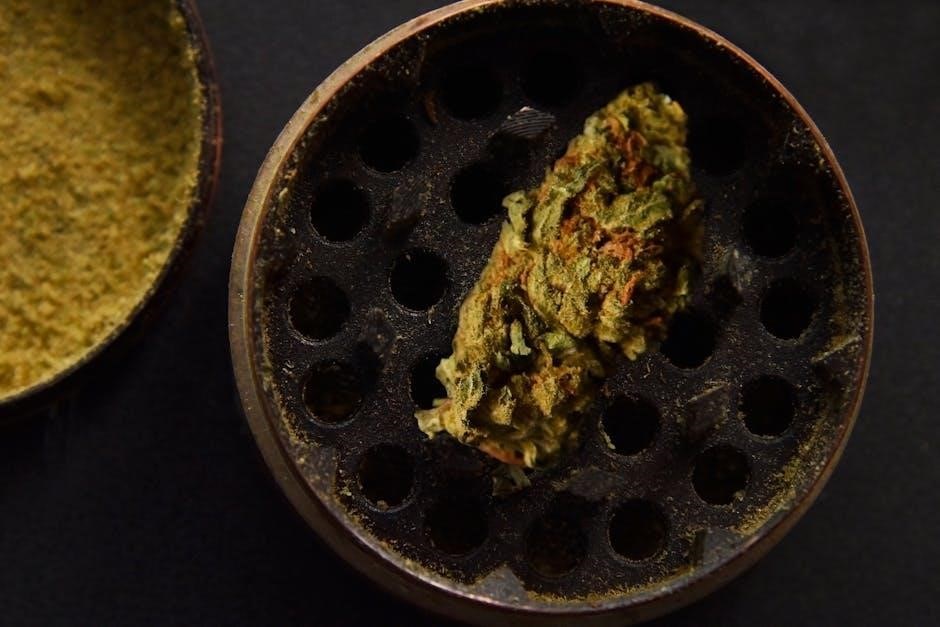
Choosing the Right Spice Grinder
A manual spice grinder is perfect for small batches, offering control over grind size without electricity․ Consider capacity and ease of cleaning for your needs․
Factors to Consider When Buying a Spice Grinder
When selecting a manual spice grinder, consider the capacity and ease of use․ Look for models with adjustable grind settings to ensure versatility․ Durability is key, as manual grinders should withstand frequent use․ Additionally, evaluate the ease of cleaning, as residue can affect flavor․ Portability and noise levels are also important for home use․ Choose a grinder that suits your spice type and quantity needs for optimal results․
Manual grinders are ideal for small batches, offering precise control over grind size․ They are cost-effective and eco-friendly, making them a great choice for home cooks; Ensure the grinder is easy to assemble and maintain for long-term satisfaction․
Capacity and Size of the Grinder
Manual spice grinders come in various sizes, catering to different needs․ Compact models are ideal for small quantities, while larger grinders suit bulk spice preparation․ Consider the capacity, typically ranging from 0․5 to 3 ounces, to ensure it matches your usage frequency․
A smaller grinder is perfect for precision and flavor retention in minimal batches, while a larger one offers convenience for frequent use․ Choose a size that fits your kitchen space and storage preferences to enhance your cooking experience․
Maintenance and Durability
Regular cleaning is essential for maintaining a manual spice grinder․ After each use, wipe the grinder with a dry cloth or paper towel to remove residue․ For tougher particles, grind rice or bread crumbs to absorb oils and odors․ Avoid using water to prevent rust or damage to moving parts․
Durable materials like stainless steel or ceramic ensure longevity․ Proper storage in a dry place and avoiding exposure to moisture are key․ Sharpening or replacing blades periodically maintains efficiency․ With consistent care, a manual grinder remains a reliable tool for fresh, flavorful spices․

How to Use a Spice Grinder
Add spices, turn the handle for precise grinding, and enjoy freshly ground flavors․ Manual grinders offer easy operation and consistent results․
Grind in short pulses, shake, and redistribute for even texture․ Perfect for enhancing dishes with fresh, aromatic spices at home;
Step-by-Step Guide to Grinding Spices
Start by adding your desired spices to the grinder, ensuring not to overfill it․ Turn the handle slowly for coarse grinding or faster for a finer texture․
For optimal results, grind in short pulses, shaking the grinder occasionally to redistribute the spices evenly․
Once ground, transfer the spices to an airtight container to preserve freshness and aroma․
Clean the grinder thoroughly after each use to prevent flavor transfer and maintain hygiene․
Preparing Spices for Grinding
Before grinding, ensure your spices are clean and dry to avoid clogging the grinder․ Remove any stems or impurities for even grinding․
For whole spices like seeds or pods, place them directly into the grinder․ If using dried herbs, crumble them slightly to facilitate grinding․
To prevent flavor contamination, grind one type of spice at a time․ For sticky or oily spices, chill them in the freezer for 10 minutes to make grinding easier․
Clean the grinder with a small amount of rice or bread crumbs before use to absorb any residual odors or oils from previous grinding sessions․
Adjusting the Grind Size
To achieve the desired grind size, most manual spice grinders feature an adjustable mechanism․ For finer grinds, tighten the setting by turning the dial clockwise․ For coarser grinds, turn it counterclockwise․
Grind in small batches and check the consistency frequently․ Sift or shake the grinder to redistribute spices for even results․ Pulse grinding in short bursts helps prevent overheating and ensures uniform particle size․
The grind size significantly impacts flavor release, so match it to your recipe needs․ Fine grinds are ideal for baking, while coarser textures suit rubs and marinades․ Experiment to find the perfect balance for your dishes․
Storing Ground Spices
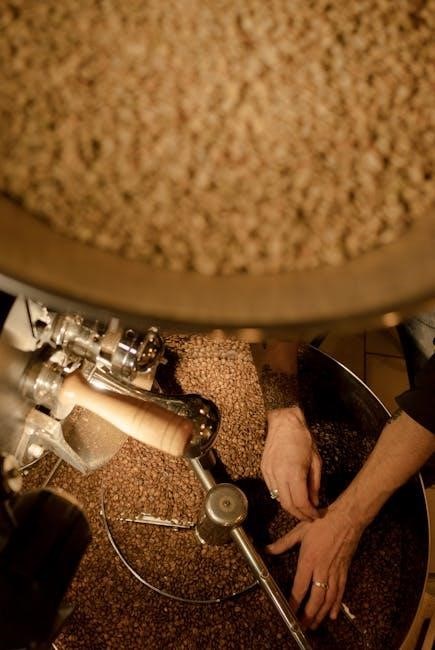
Proper storage is essential to preserve the flavor and aroma of freshly ground spices․ Transfer the ground spices to an airtight container, such as a glass jar with a tight-fitting lid, to prevent exposure to air and moisture․
Store the container in a cool, dark place, like a pantry or cupboard, away from direct sunlight and heat sources․ For maximum freshness, use small batches and grind only what you need for immediate use․
Label the containers for easy identification and consider using a spice rack to keep them organized․ Ground spices typically retain their flavor for 1-2 weeks, but refrigeration can extend this period․ For less frequently used spices, freezing is an excellent option to maintain potency․
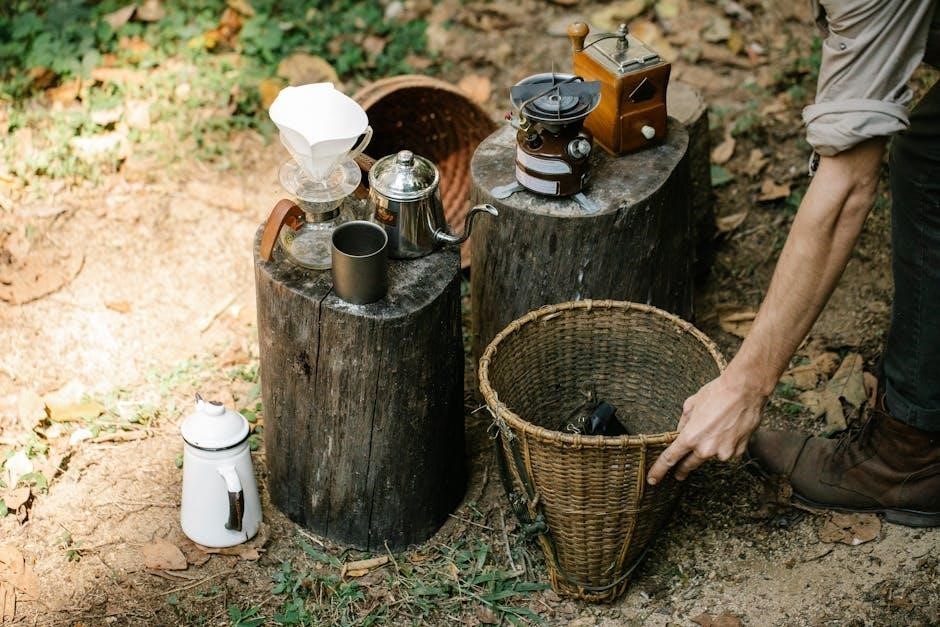
Maintenance and Cleaning
Regularly clean your manual spice grinder by brushing out residue and wiping with a dry cloth․ For tougher residue, grind rice or breadcrumbs to absorb oils and odors․
Avoid using water to prevent rust or damage․ For deep cleaning, disassemble the grinder and wash parts with mild soap, then dry thoroughly before reuse․
Cleaning the Spice Grinder
Regular cleaning of your manual spice grinder is essential to maintain hygiene and flavor integrity․ Start by brushing out any leftover spice particles using a soft-bristled brush or a clean cloth․
For tougher residue, grind a small amount of rice or breadcrumbs, which absorb oils and odors․ Discard the grounds and wipe the grinder with a dry cloth to remove any remaining debris․
Avoid using water, as it can damage the grinder or cause rust․ For deep cleaning, disassemble the grinder (if possible) and wash each part with mild soap and warm water․ Dry thoroughly before reassembling․
This ensures your grinder remains in great condition and prevents cross-contamination of flavors․ Cleaning after each use also prevents spices from becoming rancid or stale․
Sharpening the Blades
Sharpening the blades of your manual spice grinder is essential for maintaining its efficiency and ensuring optimal grinding performance․ Over time, the blades may dull due to frequent use, which can result in uneven grinding or increased effort required to grind spices․
To sharpen the blades, grind a small amount of uncooked rice or coffee beans through the grinder․ The abrasive texture of these materials helps restore the blade’s sharpness by creating friction and removing dull edges;
Repeat this process a few times until the blades feel sharp again․ For best results, sharpen the blades after every 5-10 uses to prevent them from becoming too dull․ Regular maintenance ensures your grinder continues to deliver precise and consistent results․
Regular Maintenance Tips
Regular maintenance is crucial to keep your manual spice grinder functioning efficiently and extending its lifespan․ After each use, clean the grinder thoroughly by wiping it with a dry cloth to remove any spice residue․
For deeper cleaning, grind a small amount of rice or bread crumbs to absorb oils and particles․ This helps prevent caking and keeps the grinder fresh․
Sharpen the blades periodically by grinding rice or coffee beans, which naturally restore sharpness․ Store the grinder in a dry place, away from direct sunlight, to maintain its condition․
Check for wear and tear, especially on moving parts, and address any issues promptly․ Regular care ensures your grinder remains reliable and delivers consistent results․
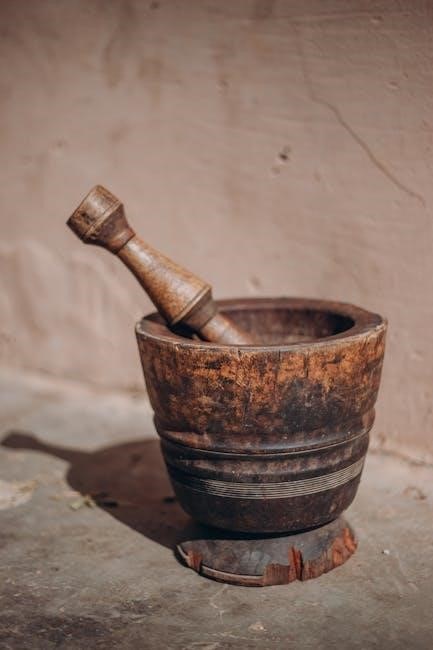
Common Mistakes to Avoid
Avoid overfilling the grinder, as it can lead to uneven grinding and damage the blades․ Always clean thoroughly after use to prevent flavor contamination and residue buildup․

Never grind wet or oily spices, as they can clog the grinder․ Using the wrong spice type for your grinder can also impair performance and longevity․
Overfilling the Grinder
Overfilling a spice grinder is a common mistake that can lead to poor grinding results and potential damage to the device․ When too many spices are added, the blades may become overloaded, causing uneven grinding and overheating․ This can result in a loss of flavor and aroma, as the spices may not be ground to the desired consistency․ Additionally, overfilling can strain the motor in electric grinders or make manual grinding more difficult․ To avoid this, measure spices carefully and grind in small batches․ For manual grinders, fill no more than halfway to ensure smooth operation․ This practice prevents clogging and ensures optimal performance, preserving both the grinder and the quality of your spices․
Not Cleaning the Grinder Properly
Not cleaning your spice grinder properly can lead to residual spices affecting the flavor of future grinds and creating hygiene issues․ Old spice particles can accumulate, causing clogging and uneven grinding․ To avoid this, clean the grinder after each use by wiping it with a dry cloth or paper towel․ For tougher residue, grind a small amount of rice or bread, which absorbs oils and particles․ Avoid using water, as it can damage manual grinders or cause rust․ Regular cleaning ensures optimal performance, prevents contamination, and keeps your spices tasting fresh․ Neglecting this step can lead to unpleasant odors and poor grinding results, making proper maintenance essential for longevity and flavor preservation․
Using the Wrong Type of Spices
Using the wrong type of spices in your manual grinder can lead to poor results and potential damage to the device․ For instance, spices with high oil content, such as nuts or seeds, can clog the grinder or leave residue, affecting its performance․ Similarly, very hard spices or large pieces may strain the mechanism or cause uneven grinding․ Always ensure the spices are dry and suitable for manual grinding․ Avoid grinding spices with high moisture content, as they can stick to the grinder’s surfaces․ Sticking to recommended spice types, such as whole peppercorns, cumin seeds, or cinnamon sticks, ensures optimal grinding and preserves the grinder’s longevity․ Proper spice selection is key to achieving the best flavor and maintaining your manual spice grinder’s functionality․

Tips and Tricks
For optimal results with a manual spice grinder, pulse grind in short bursts to avoid overheating and ensure even particle distribution․ This method prevents spices from becoming bitter․
Experiment with blending different spices to create unique flavor profiles․ Store freshly ground spices in airtight containers to preserve aroma and potency for a longer period․
Regularly cleaning the grinder with a small amount of rice or bread crumbs helps remove residual flavors and maintains its efficiency for future use․
Grinding Spices for Maximum Flavor
To maximize flavor when using a manual spice grinder, grind spices in small batches to ensure optimal freshness and aroma․ Pulse grinding in short bursts prevents overheating, which can degrade the spices’ natural oils and flavor compounds․ This technique also ensures an even grind, allowing the spices to release their full potential when cooked․ For delicate herbs, a gentle grinding motion preserves their volatile aromatic compounds, while harder spices like cinnamon sticks may require slightly more force․ Experimenting with different grind sizes can enhance specific dishes, as finer powders integrate quickly, while coarser textures add depth․ Properly storing ground spices in airtight containers immediately after grinding further retains their vibrancy and flavor․
Using the Right Amount of Spices
Using the right amount of spices is crucial for achieving balanced flavors in your dishes․ A manual spice grinder allows precise control, enabling you to measure and grind the exact quantity needed․ Start with small amounts, as freshly ground spices are potent, and adjust to taste․ For example, grinding one teaspoon of whole seeds or a few peppercorns is often sufficient for most recipes․ This approach prevents overpowering the dish and ensures each spice’s unique characteristics shine; Measuring before grinding helps maintain consistency, while grinding only what’s needed preserves the spices’ vibrancy and aroma․ This method also reduces waste and keeps your spices fresh for longer․
Pulse Grinding for Even Results
Pulse grinding is a technique that ensures even results when using a manual spice grinder․ By grinding in short bursts and allowing the grinder to cool briefly between pulses, you avoid overheating, which can degrade the spices․ This method is particularly effective for achieving a consistent texture, especially with harder spices like cinnamon or nutmeg․ Shake the grinder gently after each pulse to redistribute the spices, ensuring they grind uniformly․ Overloading the grinder can lead to uneven results, so pulse grinding helps prevent clogging and maintains efficiency․ For optimal flavor, start with pulse grinding for tougher spices and switch to continuous grinding once they become finer․ This approach preserves the integrity of the spices and enhances their aroma in your dishes․
Experimenting with Spice Blends
Experimenting with spice blends is a great way to elevate your cooking using a manual spice grinder․ By grinding small batches of spices, you can create custom mixes tailored to your recipes․ Start with classic combinations like curry powder or herb blends, or invent your own unique flavors․ The manual grinder allows precise control, ensuring each spice is evenly ground and freshly aromatic․ For example, combine coriander, cumin, and turmeric for an Indian-inspired blend, or mix basil, oregano, and thyme for an Italian-style seasoning․ Always use freshly ground spices for the most vibrant flavors․ Don’t be afraid to adjust proportions and experiment with new spices to discover exciting taste profiles․
When blending, grind each spice separately before mixing to ensure uniform texture․ This method prevents overpowering flavors and balances the blend․ Store your creations in airtight containers to preserve freshness and convenience for future meals․ Small batches allow flexibility, so you can tweak recipes easily․ Whether refining a favorite dish or exploring global cuisines, manual grinding empowers you to craft authentic, flavorful spice blends effortlessly․
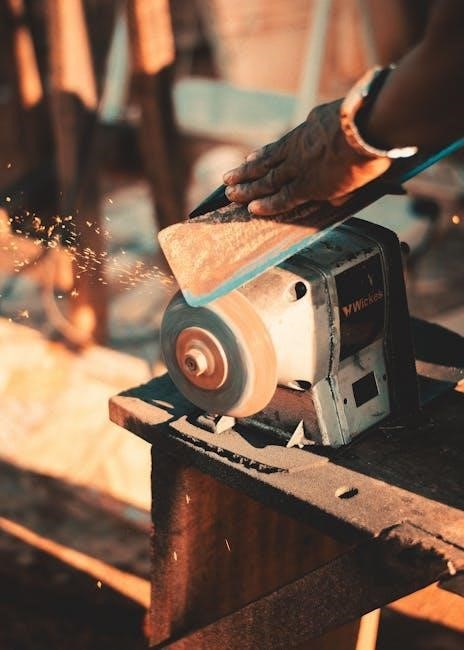
Health and Safety
Always handle sharp blades and hot surfaces with care to avoid injuries․ Keep the grinder out of children’s reach for safety․ Regularly clean and maintain the grinder to prevent contamination and ensure hygiene․ Proper storage and usage according to manufacturer instructions are crucial for safe operation․
Safety Precautions When Using a Spice Grinder
Using a spice grinder requires attention to safety to avoid accidents․ Always handle sharp blades with care, as they can cause cuts․ For manual grinders, ensure a firm grip to prevent slipping․ Keep the grinder out of reach of children to avoid mishaps․ When grinding, avoid overheating by pulsing in short bursts and allowing the grinder to cool․ Clean the grinder thoroughly after each use to prevent cross-contamination of flavors and bacterial growth․ Store the grinder in a dry, secure location to maintain its condition․ Follow the manufacturer’s instructions for proper usage and maintenance․ By adhering to these guidelines, you can ensure a safe and efficient grinding experience․
Handling Sharp Blades and Hot Surfaces
When using a manual spice grinder, always handle sharp blades with caution to avoid cuts․ Wear protective gloves or use a cloth to grip blades during cleaning or maintenance․ Avoid touching sharp edges directly, as they can cause injuries․ For grinders with electrical components, ensure they are unplugged before handling any internal parts․ Hot surfaces, typically found in electric grinders, should be avoided until they cool down․ Never leave a grinder unattended while in use, especially around children․ Proper handling and precautions ensure a safe and efficient grinding experience, protecting both the user and the device from potential damage․
Storing the Grinder Safely
Proper storage of a manual spice grinder ensures longevity and safety․ After use, clean the grinder thoroughly and dry it to prevent moisture buildup, which can lead to mold or rust․ Store the grinder in a cool, dry place, away from direct sunlight and heat sources; Use the provided storage lid or cover to protect the blades and interior from dust․ Avoid leaving spices in the grinder, as they can accumulate and cause odors․ Place the grinder out of reach of children to prevent accidental injuries․ Regularly inspect the grinder for wear and tear before storing it․ By following these steps, you ensure the grinder remains in excellent condition for future use․
A manual spice grinder is a versatile tool that enhances cooking by providing fresh, aromatic spices․ Experiment with new flavors and enjoy the culinary creativity it offers․
Final Thoughts on Using a Spice Grinder
Using a manual spice grinder is a rewarding experience that elevates your cooking by unlocking the full flavor and aroma of your spices․ By grinding spices fresh, you ensure optimal taste and texture in every dish․ Manual grinders offer precise control over the grind size, allowing you to customize your spices to suit any recipe․ Regular cleaning and maintenance are essential to keep your grinder functioning effectively․ Experiment with different spices and blends to discover new flavors and enhance your culinary creativity․ With a manual spice grinder, you can enjoy the satisfaction of freshly ground spices while adding a personal touch to your meals․ It’s a simple yet impactful tool for any home cook or enthusiast․
Encouragement to Experiment and Explore
Experimenting with your manual spice grinder can open up a world of flavors and aromas, transforming your cooking into a creative adventure․ Start by grinding small batches of single spices, like cumin or coriander, to experience their vibrant, freshly released flavors․ Gradually explore blending spices to create custom mixes for dishes like curries, marinades, or rubs․ Don’t be afraid to try less common spices, such as cardamom or turmeric, to add unique dimensions to your meals; The manual grinder’s versatility allows you to tailor grind sizes, from fine powders to coarse textures, giving you control over the final result․ Embrace the process of discovering new flavor combinations and enjoy the satisfaction of crafting something truly personal and delicious in your kitchen․